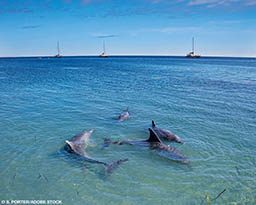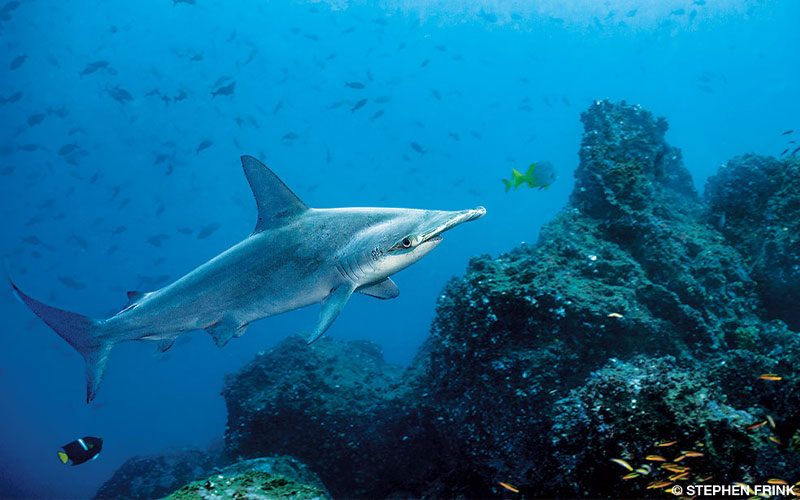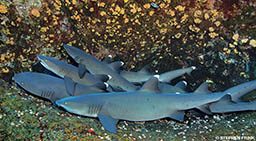Four divers descend into clear, blue water off Australia’s North West Cape. A pod of dolphins swims past about 20 yards away. A manta ray with an impressive wingspan circles above clouds of reef fish — trevally, colorful wrasses, large angelfish and butterflyfish, blue-green Chromis — schooling over a thicket of branching corals. A bright red and black nudibranch perches on the coral, while an ornate ghostpipefish hovers nearby. A stingray bursts from a patch of sandy bottom, leaving a cloud in its wake.
Australia’s 186-mile-long Ningaloo Reef contains more than 200 coral and 500 fish species and is home to hundreds of species of crustaceans, sponges, echinoderms, marine mammals and sea turtles. Protecting some 1,100 square miles of this diverse environment, Ningaloo Marine Park and Muiron Islands Marine Management Area are part of the Ningaloo Coast World Heritage Site, established in 2011.
The United Nations Educational, Scientific and Cultural Organization (UNESCO) World Heritage List recognizes places of outstanding universal value to mankind as a whole. Sites can be cultural (archeological finds, cave paintings, cathedrals, temples and the like), natural or a mixture of both. Natural sites must contain “superlative natural phenomena or areas of exceptional natural beauty and aesthetic importance” or “the most important and significant natural habitats for in situ conservation of biological diversity” or present outstanding examples of “significant ongoing ecological and biological processes.”

“World Heritage sites are exceptional, unique and irreplaceable sources of life and inspiration,” said Tegan Gourlay, acting manager of the Ningaloo Coast World Heritage Site. The site is protected and managed collaboratively by the Commonwealth of Australia, Western Australian and local governmental bodies along with scientists, businesses, traditional owners, volunteers and community members.
With a rare mix of intact and interconnected terrestrial, coastal and marine habitats, the Ningaloo Coast features an unusually narrow continental shelf that brings deep oceanic waters, reef and coastline into proximity. The resulting ecosystem supports an extraordinary array of healthy and internationally significant marine life, which made Ningaloo an excellent candidate to become a natural World Heritage Site.
Other World Heritage sites of interest to scuba divers include the Great Barrier Reef and Shark Bay in Australia; the Belize Barrier Reef Reserve System; Cocos Island National Park in Costa Rica; the Galápagos Islands; the Islands and Protected Areas of the Gulf of California and the Archipiélago de Revillagigedo in Mexico; Tubbataha Reefs Natural Park in the Philippines, and iSimangaliso Wetland Park in South Africa. Cuban scientists plan to nominate Jardines de la Reina in the next few years.

World Heritage status helps ensure these places remain accessible and attractive to future generations of divers, and UNESCO recently began an initiative to add more marine sites to the list. Governments must nominate sites (see sidebar on the nomination process), but nearly two-thirds of the world’s oceans lie beyond the jurisdiction of any nation. This vast area has yet to be considered for World Heritage status and the benefits that designation brings.
“One benefit of the status is awareness of the importance of the site,” said Alessandro Balsamo, World Heritage nominations manager for UNESCO in Paris, France. “The convention recognized the value of being part of a special and select list of the best and most well-known sites around the world. The idea is that these sites belong to all people, irrespective of where they are located.”
Tourism represents a significant source of income in many parts of the world and is a means to improve local economies and people’s lives. International recognition of the significance of World Heritage status can increase tourism, said Kateryna Wowk at the Harte Research Institute for Gulf of Mexico Studies at Texas A&M University–Corpus Christi. In 2010 Wowk worked with UNESCO and colleagues from Kiribati on inscription of the Phoenix Islands Protected Area as a World Heritage Site.
“Once a site is inscribed though, managers need to come up with funds to manage it. These are not supposed to be paper parks,” Wowk stressed. “The crux of it is that some sites come out ahead economically due to increased tourism, and some do not. It’s not necessarily always an economic win, but that’s not what the convention is about. If the main goal is an increase in revenue from the site, there are probably better tools. But if preserving a special area is the goal, World Heritage status can be quite a beneficial tool.” It is also a good indicator that a place is worth a dive trip, she added.

World Heritage designation also helps raise global and local awareness of key ocean conservation concerns. “My belief is that if you take it seriously, it will facilitate the goal of long-term preservation and conservation,” Wowk said. “It can succeed in that goal, but the country has to take the initiative.”
Countries can take advantage of UNESCO technical training for World Heritage site managers and get assistance with management, sustainable tourism development and science-based monitoring. Sites can turn to an international community of experts and funding to facilitate the mission of the site and help managers solve problems and advocate more effectively for protection. Sites in developing countries also gain access to World Heritage funds, including emergency funds to help repair damage from human or natural disasters such as oil spills and hurricanes.
“We share and provide expertise,” Balsamo said. “This program is the main international instrument to protect nature and culture. The basis of the system is the idea that our cultural and natural heritages are irreplaceable. It is one of the most signed, most universal, of all United Nations conventions. We try to make sure that all people, especially people living in and around the sites, know about their importance. That is the basis of good management.”

Socorro Islands.
Being placed on the list comes with requirements for monitoring, evaluating and reporting, a key part of the program and a central difference between it and marine protected areas named by individual countries.
UNESCO periodically checks the status of conservation efforts at sites. About 150 sites each year produce a report outlining the potential issues affecting site conservation, and the World Heritage Committee, made up of representatives from 21 of the convention’s signatories, review a selection of these reports.
This annual process provides an opportunity for the global community to help find solutions to local issues, says Fanny Douvere, coordinator of the World Heritage Marine Program. “We can bring local concerns to the world stage.”
Every six years state parties can submit a report on all sites within their territories, which further promotes regional collaboration. Every three years site managers come together to network and hear from global experts in a variety of fields. “A lot of sites deal with the same problems, and the wheel is constantly being reinvented,” Douvere said. “These managers have a lot of experience with what works and what does not, but they typically don’t attend international conferences. The regional meetings provide opportunities for them to share their knowledge.”
All sites must prepare a management plan that explains how the country will conserve a site’s value over the years. The committee can remove from the list sites that do not follow that plan, but that has happened only twice in 40 years.
The committee can also place — or threaten to place — a site on the List of World Heritage in Danger. In 2012, for example, the committee warned managers of the Great Barrier Reef site that they needed to demonstrate substantial progress within a year or be placed on the danger list. As a result, the Australian government banned dumping of dredged material within the site, restructured port development near the reef and pledged to reduce polluted runoff by 80 percent by 2025. After the Belize Barrier Reef went onto the danger list in 2009, the Belizean government permanently banned oil exploration in the site and in February 2016 approved a coastal-management plan to help protect it.
The committee expects two issues to have the most significant effect on marine sites in the coming decade: climate change and illegal, unreported and unsustainable fisheries. “One key challenge with fisheries is that we don’t clearly know how much is taken out of these sites,” Douvere said.
Divers and others can help with monitoring fishing and other activities at sites that they visit. “We count very much on private citizens to warn us about things that are going wrong,” Balsamo said. “People can call our attention to things. We’ll communicate with the state party, see if something is going on and whether we can do something about it. Anyone concerned about the conservation of a site can and should write to us. It is always best to include scientific information or pictures, which sometimes speak better than words.”
Douvere said that divers can share photographs and video to help the organization raise visibility and awareness of sites as well. “Divers see things,” she added. “They are in the water and are very knowledgeable.”
As our dive on Ningaloo Reef ends, the manta ray still glides nearby, with a shimmering cloud of tiny silver fish providing a backdrop for its underwater ballet.
“This is one of the longest, most complex and pristine fringing reefs in the world,” Gourlay said. “We have a responsibility to care for the Ningaloo Coast — and other World Heritage sites — to ensure these biologically important habitats, plants and animals are protected and so future generations can experience these wonders.”
Selection Process
Countries that signed the convention (i.e., state parties) may nominate a site for inscription onto the World Heritage List. A state party must first inventory important natural and cultural heritage in its territory in what is known as a tentative list. Currently the committee limits nominations to two per state party and 45 total each year. In 2019 that will change to one per state party and 35 overall.
The deadline for nominations is Feb. 1. Following an initial committee review, parties have one month to transmit a complete application to the appropriate advisory body, which for natural sites is the International Union for Conservation of Nature (IUCN). The IUCN evaluates applications and submits a recommendation. The full committee assesses all nominations at its annual meeting, making one of four decisions: inscribe a site on the list, request additional information for the following session, defer nomination, or noninscription. A noninscription decision means the nomination cannot be resubmitted in the same format.
Individuals who think a place should be nominated must go through channels with the appropriate state party.
Successful nominations include economic data on tourism and conservation and international comparison studies. Parties are asked to involve local populations in the process, as people who know the value of a site will better protect it.
World Heritage Sites by the Numbers*
- 1,052 total sites
- 203 natural sites
- 814 cultural sites
- 35 mixed natural and cultural sites
- 49 marine sites in 37 countries
- 29 marine sites with coral reef systems
- 193 state parties to the World Heritage Convention
*NOTE: The number of World Heritage Sites increased to 1,073 in July after this issue went to press. Read more information about the 21 new sites — 18 cultural and three natural.
Explore More
© Alert Diver — Q3 2017

